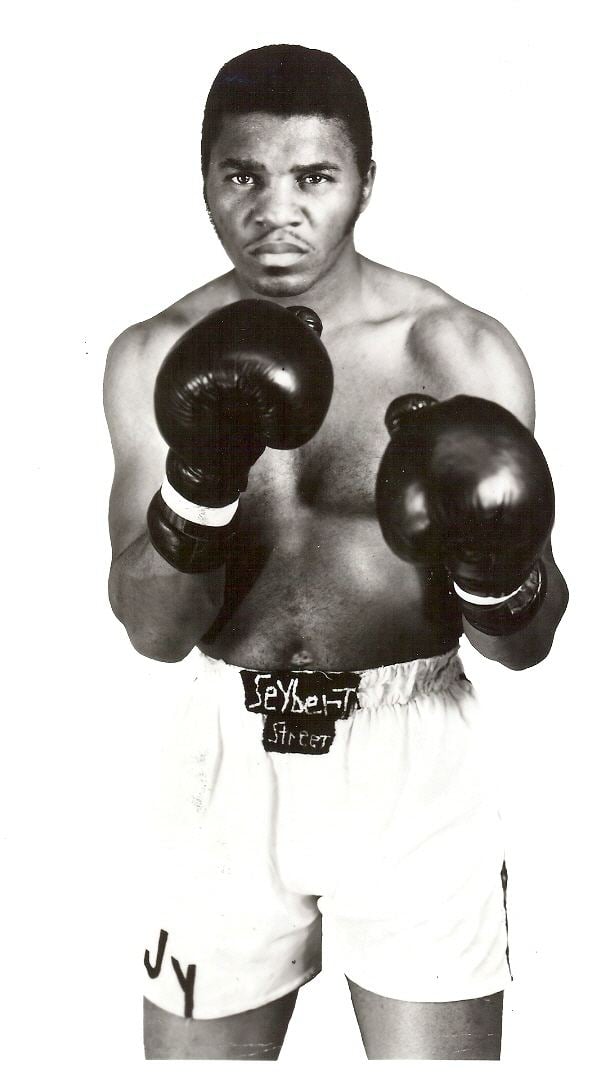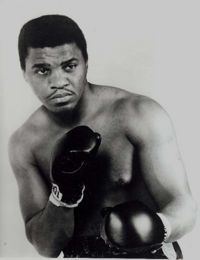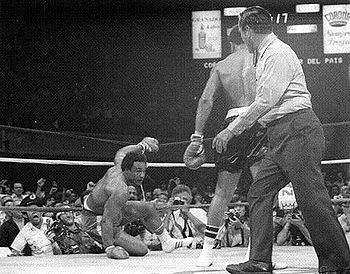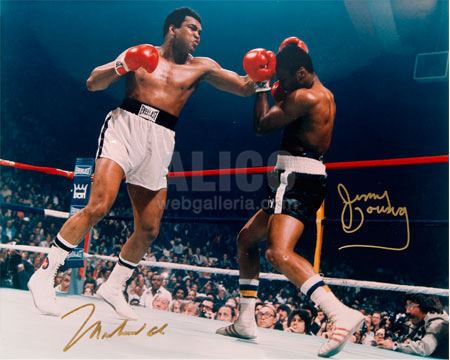Real name Jimmy Young Wins by KO 11 Height 1.88 m Wins 34 Role Boxer Total fights 56 | Nationality United States Name Jimmy Young Rated at Heavyweight Losses 19 Martial art Boxing | |
 | ||
Died February 20, 2005, Philadelphia, Pennsylvania, United States | ||
Jimmy young highlights defensive skills
Jimmy Young (November 14, 1948 – February 20, 2005) was an American professional boxer who had his greatest success at heavyweight during the mid 1970s, most notably when he beat George Foreman in 1977 and lost the year beforehand a disputed decision against Muhammad Ali in 1976. Young fought many significant fighters of his era, including twice outpointing Ron Lyle and losing only by a split decision to then-number one contender Ken Norton in a title eliminator in late 1977.
Contents
- Jimmy young highlights defensive skills
- Early fights
- The YoungAli fight
- Rematch Lyle and then George Foreman
- The YoungNorton eliminator fight
- The slide Ocasio twice
- Later career
- Biography
- Comeback chance
- Later years and death
- References

Early fights

Inexperienced in only his 11th professional fight, Young was matched against contender Earnie Shavers, who had a 42-2 record at the time and suffered his first KO loss. Young had tried trading blows and was caught early on by one of the division's hardest punchers. Shavers was infamous for his overwhelming early attacks. They would fight again, however.

After this Young learnt fast and went undefeated for three years which included a win over contender Ron Lyle and a controversial draw in a re-match with Earnie Shavers (many observers scored the bout for Young). It would not be the last time Young lost a decision in a big fight. He had worked better on defense against this known devastating hitter. It was still enough to earn him a title fight with Heavyweight Champion of the World Muhammad Ali.
The Young–Ali fight

Young made his name globally and with the public when he fought Muhammad Ali in Landover, Maryland in April 1976 for the world heavyweight title, although boxing circles had already noted his ability. Ali weighed in at 230 pounds, the highest for any of his fights up to that point (he would weigh 236.25 pounds in his fight against Trevor Berbick), and was consequently slow and immobile throughout the bout. Seven years younger and 21 pounds lighter, Young adopted a strategy of fighting aggressively from a distance, landing numerous light blows while dodging and parrying Ali's counterpunches, and using his body blows, which had little power behind them but were effective at scoring points. At close quarters, Young would turn passive. He retreated whenever possible, and often kept his head ducked very low to avoid serious blows when Ali would fight from the inside.
On several occasions when Ali was inside and Young had his back to the ropes, Young would intentionally put his head or upper body out of the ring to compel the referee to separate the fighters. To some, Young's was a brilliant strategy of neutralizing his opponent's strengths and forcing the bout to be fought on his own terms, exposing Ali's inability to fight a counterpuncher. To others, it seemed cowardly as he forced a stoppage to the fight every time Ali held the advantage.
The referee did at one point during the fight initiate a count due to Jimmy Young being outside the ropes. The fight went the full 15 rounds with a controversial one-sided unanimous decision going to Ali. Referee Tom Kelly scored it 72-65; judges Larry Barrett and Terry Moore had it 70-68 and 71-64, respectively.
Ken Norton (a rival of Ali) who was commentating at ringside had the fight even on his own scorecard. Lester Bromberg (former Ring magazine editor) called the decision a "travesty". New York Daily News reporter Dick Young said: "[Ali won] by the grace of three hero worshipping fight officials. I believe many people, the voting officials among them, refuse to believe what they see when one of their super-heroes doesn't function as expected." As the fight was televised, many viewers called to the network to complain about the decision. Even Ali's ever loyal trainer Angelo Dundee went on record as saying this was the champion's "worst fight". Afterwards, many started calling on Ali to retire. Some claimed that Young's performance should have earned him a rematch. The WBC for one agreed this and set about organising it in 1977 as below.
Rematch Lyle and then George Foreman
In November 1976 Young in a rematch again clearly beat heralded contender Ron Lyle by using clever defense and fast offensive styles. On one judge's card winning 11 of all 12 rounds.
In March 1977, Young then fought George Foreman in San Juan, Puerto Rico. Foreman was on his own 5-0-0 comeback after losing the title to Muhammad Ali in "The Rumble in the Jungle", including victories over top contenders Ron Lyle and Joe Frazier.
The Young-Foreman fight was somewhat steady until the sixth round. The early rounds were punctuated by complaints from Young and his corner about the use of elbows by Foreman, which was punished by the referee by a point deduction. For the first half of the fight, Young used his somewhat unorthodox boxing skills and good defense to keep out of harms way, while using his punching speed to counter. In the sixth round he became somewhat more aggressive himself and landed a number of clean punches on Foreman. Eleven seconds into the seventh round, Foreman caught Young with a left-handed body punch, and immediately followed with a powerful swinging left hand to the head. Young reeled and turned away and seemed about to go down, while Foreman tried to pursue his advantage, but somehow Young survived to the end of the round. In his after-match comments on TV, he described it as 'desperation'. But Young rallied, and landed a number of good punches of his own, as Foreman's eyes became puffy and his punches lost their menace. For the rest of the contest, Foreman continued to move forward, trying to cut off the ring and looking for the big knock out, while taking punches from the elusive Young. Finally Young even managed a knockdown over Foreman in the last round, and earned a unanimous win by 12-round decision. The Ring named the Young-Foreman bout its 1977 "Fight of the Year". Jimmy Young joined Ali in being the only two men to ever beat a peak George Foreman in over 40 contests.
The Young–Norton eliminator fight
Now the number 2 contender, Young's next opponent in November 1977 was in a big mandatory world title eliminator against Ken Norton the number 1 contender – Jimmy had won five straight since his loss to Ali, including another clear unanimous decision over Ron Lyle.
Young lost the Norton match on a controversial split decision in which many observers watching in attendance felt Young should have been declared the winner in a clever fight from both boxers in Las Vegas. While Young boxed, cleverly drawing Norton onto useful sneak right hands, Norton himself pressed forward dangerously, always his best style, using a heavy two-handed attack pounding away to the ribs, then lobbing wicked head shots. The two had sparred when Ken trained for his second Ali match, and Norton had found shots thrown first to the head rarely landed so this gave him the tactic's idea. The fight was set at 15 rounds, unheard of for a non-title match but it was due to its importance as an eliminator (and later retro-designated as a WBC title match). It attracted big money and Ali himself was ringside. The winner of the fight, Norton, was later awarded the WBC championship belt as the mandatory title defence didn't materialise when Leon Spinks (who had taken the title from Ali in an upset win on February 15, 1978) chose a rematch against Ali instead of fighting Norton for the WBC-title.
The slide; Ocasio twice
Demoralised at having lost another close decision, Young went on a gradual downward spiral. In June 1978 You're only as good as your last fight, boxing's old saying seemed to apply. Poor conditioning, an increasing problem, let him be outpointed by prospect Ossie Ocasio. Whilst better in a direct rematch, early 1979, Ocasio again showing talent edged the win and went on to fight the world champion Larry Holmes.
Later career
He won a short 3 round brutal battle with unranked Wendell Bailey, flashes of old form. But other matches of note; Young was stopped 'on cuts' to new heavyweight contender Gerry Cooney after 4 rounds in an about evens match. He'd also lost on points to another rising prospect and future heavyweight champion Michael Dokes. In the 1979 Dokes match Young had scaled 229 lbs,around 15lbs overweight, it was a near career heaviest and he was simply way out of shape untrained.
But slimmed down again he later in the same year December 1979 outpointed British champion John L. Gardner effectively, even decking Gardiner in the 10th. That and the Marvin Stinson and Jeff Sims matches were probably his last notable wins.
Biography
Young's biography was published in 1979, Jimmy Young, Heavyweight Challenger by Edward Dolan and Richard Lyttle, Doubleday pub, ISBN 0-385-14097-5.
Comeback chance
Young began a comeback, going 5-0-0 including a TKO over previously unbeaten Gordon Racette. In 1982, Young's comeback was cut short when he was defeated on points by future champion Greg Page. He became a "trial horse" for emerging contenders, dropping decisions to more future champions in Tony Tucker and Tony Tubbs. He continued fighting with mixed results until 1988, aged 39 years old.
Later years and death
After his boxing career, Young had financial, drug, and legal problems. During a court hearing on a drug possession charge, it was argued by his Philadelphia public defender that Young had symptoms of chronic traumatic brain injury (due to the sport). At a boxing celebrity event, Ring magazine noted Young was helped about by family.
Young died on February 20, 2005 of a heart attack, after six days in the hospital, aged only 56.
